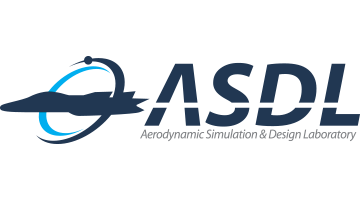Aerodynamic Design Optimization
In the general field of aerodynamics, as with any field theory, we are faced with two problems, analysis and design. In the case of design problem we are asked to predict the geometry of the object, which must be compatible with the desired features of the flow-field. The aerodynamic design has become the essential part in the area of aircraft design. Before the 1980s, aerodynamic shape design was carried out with a data of experiments and an intuition of designer. However, a development of computational power induces a growth of the numerical aerodynamic shape design and optimization that is a combination of the computational flow analysis methodology and the computational optimization methodology.
There are two design methodologies classified by the approach, which are inverse design method and direct design method. The inverse design finds the optimized geometry by the prediction of optimized pressure distributions in the presented flow conditions. For example, it is possible to determine the coordinates of an airfoil if a surface pressure distribution is specified. On the other hands, the direct design predicts the optimization value of the objective function that represents the performance of objects. In the design domain with such constraints, the optimized geometry is found at the point where the objective function reaches to the minimum or maximum.
In the Aerodynamic Simulation and Design Laboratory (ASDL), Aerodynamic shape design and optimization is performed with high-fidelity and accurate computational analysis and optimization methodologies. Especially, shape optimizations of airfoil, multi-elements airfoil, wing, aircraft of wing-body configuration, and S-duct are conducted.
There are two design methodologies classified by the approach, which are inverse design method and direct design method. The inverse design finds the optimized geometry by the prediction of optimized pressure distributions in the presented flow conditions. For example, it is possible to determine the coordinates of an airfoil if a surface pressure distribution is specified. On the other hands, the direct design predicts the optimization value of the objective function that represents the performance of objects. In the design domain with such constraints, the optimized geometry is found at the point where the objective function reaches to the minimum or maximum.
In the Aerodynamic Simulation and Design Laboratory (ASDL), Aerodynamic shape design and optimization is performed with high-fidelity and accurate computational analysis and optimization methodologies. Especially, shape optimizations of airfoil, multi-elements airfoil, wing, aircraft of wing-body configuration, and S-duct are conducted.
Ⅰ. Design of Multi-element airfoil
Generally, the aircraft flies with three phases; these are take-off, cruise, and landing. In the low-speed range of take-off and the landing phases, the aircraft desires high-lift force to rise up or to endure gravity. On the other hands, the cruse phase needs to diminish the drag force for efficient flying. To satisfy the several requests, the high-lift devices such as flap and slat are proposed and widely used. We designed the optimized multi-element airfoil for maximizing the lift forces by shape design.

Fig. 1. Design of aircraft wing and aircraft wing-body configuration
Ⅱ. Design of aircraft wing and aircraft wing-body configuration
Almost all of commercial aircraft flies in Mach 0.8~0.9, which condition makes several special flow phenomena such as shock, flow separation, and so on. Especially, we have concentrated on the shock because it is the main cause of drag-forces. So, we designed the shock-free wing by elimination of the shock on the wing-upper-surface. As a further research, the wing-body configuration was designed with planform and wing surface modifications. This design remarkably reduced the drag forces originated from the flow separation on the junction of wing-body and the shock of the transonic wing.

Fig. 2. Aerodynamic shape design of wing-body configuration
Ⅲ. Shape design of S-duct and flow control device
Although the S-shaped intake is an integral and essential part of aircraft to supply mass flow to aircraft engine, the flow distortion and the decrease of total pressure are occurred in the intake. These phenomena become the cause of the drop in engine performance. In this reason, we designed the shape of S-duct to eliminate distortion and to increase total pressure recovery rate. Even though the shape design had been conducted well, the flow control devices was installed and designed in S-duct to maximize the intake performances.

Fig. 3. Design of S-duct






